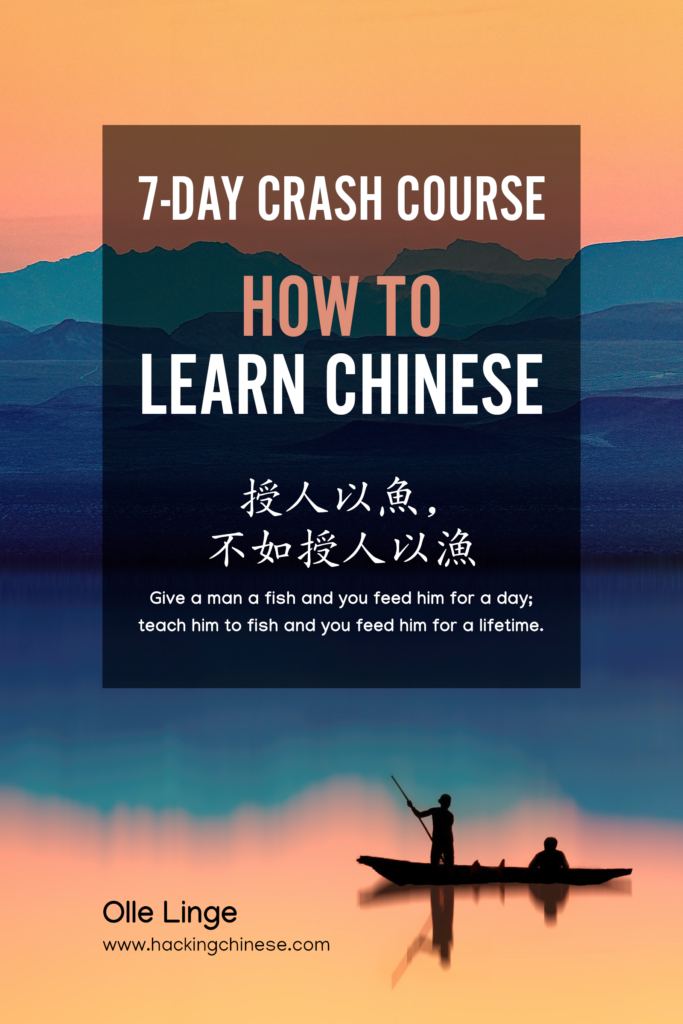 Deciding how to best invest your time as a learner of Chinese is not easy. Everybody agrees that input through listening and reading is necessary to learn a language, but what else should you do and how much?
Deciding how to best invest your time as a learner of Chinese is not easy. Everybody agrees that input through listening and reading is necessary to learn a language, but what else should you do and how much?
Some people claim that input is all you need, while others believe that supplementing it with deliberate practice and study is crucial.
But beyond that, there’s an even more indirect question: how much time should you spend learning how to learn?
Will Hacking Chinese help you learn Mandarin?
Or, more broadly, how important is it to learn how to learn? The obvious answer is that a vast majority of the time should be spent engaging with the language, not learning about the language or exploring strategies for how to learn more efficiently.
Reading Hacking Chinese or listening to my podcast comes with an opportunity cost: you could have used that time to listen to or read Chinese directly instead. So why should you spend any time at all on Hacking Chinese?
Learning how to learn Chinese is a long-term investment
Let’s take a cycle race to illustrate why I think it’s worthwhile to invest some time into finding a better way of learning.
We have two amateur cyclists, A and B, with identical endurance and skill, but who approach the race differently. A sets out immediately at a pace of 25 km/h.
In contrast, B spends four hours watching videos about proper cycling technique, reading an article about how to train for long-distance cycling, and maybe buying a decent bike. Because of these upgrades, she’s able to pedal away at a higher speed, let’s say 30 km/h.
For short distances, it should be obvious that A will win, because she started moving immediately. There are many examples in language learning where such a direct approach makes sense.
For example, cramming is a valid method if you have a test next week. It works a lot better than spaced repetition, which is what I would normally advocate.
Cramming vs. spaced repetition: When to use which method to learn Chinese
In this situation, it should be obvious that reading my article about which method is best has zero impact on your chances of passing the exam. You’re better off using either method.
Similarly, if you want to learn ten Chinese characters, rote memorisation is faster than learning how characters work, analysing the components of each character and linking them together in memorable ways, at least if you have a dictation test tomorrow.
Learning Chinese is a long-term project
For most people, learning Chinese is a long-term project. Your goal is not to pass the exam next Thursday but to learn the language so you can use it spontaneously in unrehearsed interactions.
Your goal is not to learn twenty characters by tomorrow, but thousands of characters so you can read stories, emails, news articles and novels.
Let’s return to our cyclists to explore how the length of the race impacts what strategies work best for winning it.
A, who set out immediately at 25 km/h, will win if the race is shorter than 600 km. In the four hours it took B to prepare, A will have gathered a 100 km head start. Since B’s speed is 5 km/h faster, it takes 20 hours to catch up, or 600 km.
The longer the race, the more important the method
As we can see, “just do it” works very well for most realistic races, as long as you only plan to do one of them. Spending too much time thinking about strategy simply doesn’t pay off.
However, in a competition such as the Tour de France, usually around 3,500 km in total, sacrificing a few hours to upgrade your speed is well worth it, and B would finish the whole race roughly 23 hours faster than A (117 vs. 140 hours).
Learning Chinese is more like circumventing the Earth than cycling around France, however. If it were possible to bike along the equator around the globe, B would arrive more than 11 days before A.
Learning Chinese is actually not like cycling
Naturally, the numbers here are arbitrary and learning Chinese is not like cycling (it’s actually more like walking a thousand miles, as I’ve argued here).
Furthermore, some methods differ much more from each other than 25 km/h and 30 km/h.
Learning thousands of Chinese characters by rote is probably several times more time-consuming (if it’s even possible) than smarter methods.
If you waste time on something that doesn’t bring you closer to your goal at all, your speed is effectively 0 km/h, making it essential to consider your approach.
Learning Chinese is more like walking a thousand miles than running 100-metre dash
Tweaking as you learn rather than never getting started
If the race is long enough, even small improvements in your learning method are important. This doesn’t mean that you should try to find the perfect method before you even start, however. Instead, make sure you get rolling and then tweak your method as you go along.
This ensures you start learning, but also allows you to upgrade your method and accelerate your learning over time.
Trying to find the perfect method before you start is also doomed to fail; you simply can’t evaluate most approaches to learning unless you’ve tried them, so tweaking too much before you start is just a waste of time.
To add insult to injury, it’s unlikely that the best method to learn will remain the same during your entire journey, from beginner to intermediate to advanced, so continuously learning and adapting is the only way.
Hacking Chinese as a complement to learning, not a substitute
My goal with Hacking Chinese is to help you with the tweaking, but it should be clear by now that tweaking in itself will not bring you to the finish line, nor even out of the garage.
Reading or listening to Hacking Chinese will not by itself teach you Mandarin. This was never the goal.
If you’re not already engaging a lot with the language, you should start doing so before spending any more time on my articles or podcast episodes.
It’s worth noting that there is a risk that reading about how to learn acts as a substitute for actually learning, just like reading self-help books might stop you from helping yourself (read this insightful article by Scott Young).
My hope is that the time you spend on Hacking Chinese is worthwhile, both because I hope that I can inspire you to invest more time, but also because the information I provide will help you tweak your method.
If you’ve read this far, you’ve probably filled your learning-about-how-to-learn quota for the day. Time to read a story or listen to a podcast!
Let’s go:
The 10 best free Chinese reading resources for beginner, intermediate and advanced learners
The 10 best free Chinese listening resources for beginner, intermediate and advanced learners
Good luck! 加油!
